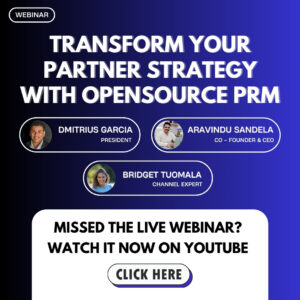Mergers are a chaotic time for everyone. You have to figure out how to merge your finances, your departments, your partner programs, and much more. Your partners are going to be wondering exactly what is happening with your partner program and what it means for them. You’ll also have to pick and choose which aspects of your partner program you want to keep and why.
Here’s 3 things you should do to help guide your partners through the merger and how partner insights can help you decide which parts of your partner program you should keep.
- Communicate, communicate, communicate
Everything runs on proper communication. As soon as you find out what the merger means for your partner program let your partners know. Your partners will need to know what the new system looks like and what it means for them. Make sure to introduce them to any new channel managers or other team members they may be working with in the future. Make sure to make yourself or one of your other team members available to answer any questions they have.
Constantly communicating with your partners during this process will show your partners that you’re thinking about them and how the merger will affect their business. This will strengthen your relationship with them and in turn, their engagement. Also, make sure to note down any questions or feedback they have so you can address it when merging your partner programs.
- Train your partners, train your team, train yourself
Unfortunately, figuring out what to tell your partners isn’t the only thing you have to do. You have to figure out how to merge your partner programs. Is one partner program more mature than the other? Which elements of the partner programs should you keep? Should you get rid of any elements? What are the costs of switching partners from one program to another? Should you keep the platforms’ partners used or should you switch everyone to a new one?
All of these are questions you will have to ask before you decide how to move forward with a new or combined partner program. Often this will mean training your partners and yourself on a new tool that you’ll have to use. You’ll have to create a training program, schedule webinars, and maybe even sit down with them and walk them through the new tool.
Along with training your partners on new tools, your team will have to be trained as well. So will you. This is harder than it sounds as your business doesn’t stop running when you undergo a merger. You have to find time to train your team and yourself while still keeping up with your responsibilities.
If possible try and train your team and your partners together. This will help your team and your partners get to know each other and start building a relationship. Your partners will know who they can contact with questions, issues or advice and your team can get immediate feedback on the new tools.
- Make things easier
A merger is a great time to take a look at what’s worked and what hasn’t. Your workflows are changing, your tools are changing, and you’ve gotten new people with new ideas. Set up some time with your team, bring the feedback your partners have given you and think of some ways to make things easier on your partners.
That could look like having more regular meetings with your partners. Maybe you only met once or twice a month before and your partners would prefer meeting on a weekly basis. Perhaps your partners are overwhelmed with your onboarding process and want a quick start guide on how to jump in and start selling. Or maybe you want more insight into how your partners use your content and want to introduce or switch to a new tool. Whatever it is, now is a good time to restructure your partner program to make things easier for your partners.
How partner insights make mergers easier
If you’re currently undergoing a merger, this is an intimately familiar scenario. Your company has announced that it’s merging with another company and the next thing you know, you’ve got someone in your office asking you about your partner program. They’ll probably want to know what tools you use to manage your program, how many people are on your team and your ideal partner profile. But, then they’ll want to know things like who are your top performing partners? What percentage of revenue comes from your partners? How many leads do your partners generate?
Do you find yourself struggling to answer those questions? You can answer some of these questions with the deal registration form data you get from your partners, but not all of them. Previously, we talked about how to actually measure partner engagement and what those metrics tell you in our post: The True Measure of Partner Engagement. With those metrics, you can easily answer the question of who your top performing partners are and talk your partners up to your new team members.
Metrics such as Marketing Activities and Social Sales measure how much marketing your partners do on your behalf and the types of marketing and sales activities your partners do. These can be used to show how engaged your partners are and what type of support they may need from your new partner program. Here’s an example.
Everytime you make a major change to your product, Partner A sends out an email campaign to their customers describing the change and how it benefits them. They also reshare every single one of your social posts and constantly ask to run webinars with them, host conferences and be a guest host on their weekly podcast. They’re really enthusiastic about marketing you and they generate a lot of potential leads. But, they don’t share them with you.
Partner A doesn’t need any help with their marketing efforts. Their marketing actives and social sales scores are within your excellent range. However, their lead generation score, the metric that measures how many leads your partners share with you, isn’t great. You talk to them and realize that they’re confused about your lead criteria, especially since you’re undergoing a merger. Then, you go back, discuss with your team and decide to send out an email outlining the changes to your lead criteria. You also put these updates into your partner portal so your partners can view them at any time.
Now, your partners are happy because they know what types of leads they should give you to get their commission and you’re happy because you’re getting the types of leads you want. These types of insights makes it easier to decide how to best merge your partner programs because you can spot areas where your partners seem to struggle and look for ways to help. It helps you make a case for any elements of the partner program that you want to get rid of as you can point to the data and say this is why our current partners were struggling.
Conclusion
Mergers are chaotic times where everything changes. You’ll have to be the one guiding your partners and your team through the changes. You’ll also have to convince your bosses which parts of your partner program are worth keeping or should be discarded and data is your most powerful tool in that conversation.
Constantly communicating with your partners will make the changes easier for you and them. You’ll also have to train everyone and yourself on any new tools you decide to use. You’ll be getting a lot of questions and feedback in this process which you can then use to simplify your new partner program for your partners.
Finally, measuring your partners’ sales and marketing activities can give you a good idea of which parts of your partner program are worth keeping and which ones could use a change. This data, along with the feedback you get from your partners will help you take the best elements of both companies’ partner programs and create a better one for the new company going forward.


